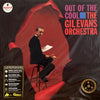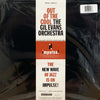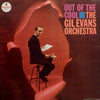





The Gil Evans Orchestra - Out Of The Cool (2LP, 45RPM)
ORDER LIMITED TO ONE ITEM PER CUSTOMER
Gil Evans – piano [click here to see more vinyl featuring Gil Evans]
Johnny Coles – trumpet (soloist)
Phil Sunkel – trumpet
Keg Johnson – trombone
Jimmy Knepper – trombone
Tony Studd – bass trombone (soloist)
Bill Barber – tuba
Ray Beckenstein – alto saxophone, flute, piccolo
Eddie Caine – alto saxophone, flute, piccolo
Budd Johnson – tenor saxophone, soprano saxophone (soloist)
Bob Tricarico – flute, piccolo, bassoon
Ray Crawford – guitar (soloist)
Ron Carter – bass [click here to see more vinyl featuring Ron Carter]
Elvin Jones – drums, percussion [click here to see more vinyl featuring Elvin Jones]
Charlie Persip – drums
2 LP, gatefold old-style tip-on jackets
Limited edition
Original analog Master tape : YES
Heavy Press : 180g
Record color : black
Speed : 45RPM
Size : 12”
Stereo
Studio
Record Press : Quality Record Pressings
Label : Analogue Productions
Original Label : Impulse
Recorded November 18 & 30, December 10 & 15, 1960 in Van Gelder Studio, Englewood Cliffs, New Jersey
Engineered & mixed by Rudy Van Gelder
Produced by Creed Taylor
Remastered by Kevin Gray, Steve Hoffman (C1, C2, D) at AcousTech Mastering
Originally released in 1961
Reissued in 2009
Tracks:
Side A :
- La Nevada
Side B :
- Where Flamingos Fly
Side C :
- Bilbao Song
- Stratusphunk
Side D :
- Sunken Treasure
Reviews :
"Last winter an old audio biz friend of mine visited bearing a gift: a new Italian 45rpm pressing of Gil Evans' dark, brooding and oh so slinky 1960 recording of Out of the Cool originally issued in 1961 by the then new Impulse! label created by producer Creed Taylor for parent company ABC-Paramount. The album was Impulse! A-4, the label's fourth release.
This reissue on the DOXY label puts the entire album on a single 45rpm record. Given that side one runs almost 21 minutes, I was surprised they squeezed it onto a single side. Sides two's approximately 16 minutes is slightly more manageable with "slightly" the operative word.
The original's inner gatefold features a black and white profile of Evans on the left side and annotation by Tom Stewart on the right, along with a layout of the instrumentation and who plays what. It even tells you what microphones were used for each instrument. "Minimally miked" this ain't but it results in timbral richness and transient clarity as well as a dramatic instrumental presence. While the layout arrays most of the instruments across a "U" shaped stage the final mix doesn't strictly follow the diagram.
With its orange and black spine, high gloss gatefold jackets and exclamation point logo, the label had a distinctive look. For this and many outings, Taylor went to recording great Rudy Van Gelder who created for the label a sonic presentation distinct from the famous cavernous, reverberant Blue Note sound, though by this time Van Gelder had moved from his Hackensack living room studio to a larger facility in Englewood Cliffs, NJ so the Blue Note Sound itself was somewhat different as well.
The album's opener, a fifteen minute G minor 7th/G major vamp called "La Nevada" is an improvised tune built upon a now familiar (to Evans and Miles Davis fans at least) theme and of course reminiscent of some of Kind of Blue as well as, of course, Evans' earlier collaborations with Miles. It opens with Evan's piano center stage, bathed in a reverberant field. A shaker enters on the right channel along with Elvin Jones's ride cymbal and snare. On the left channel Ray Crawford's hollow bodied electric guitar enters with a figure that will remind many of Bitches Brew, which wouldn't exist until the end of the decade. In fact, the whole record, including some of John Coles's trumpet part presages Bitches Brew, though Evans uses growling brass here, including tuba, bass trombone, and trombone and relies on his signature woodwind/brass interface to drive the tunes. Bitches Brew was far more a rhythmic and electric exercise.
I've been asked many times to produce a top 10 or top 100 LPs list and this record would be right near the top both because of how it has influenced jazz (and surely Henry Mancini I'd say) and because it's superbly produced, engineered and especially played. The improvised performances are astonishing every play and the sound is superbly transparent, vivid and dynamic, though the soundstage is unnaturally wide with most instruments hard left and right, but don't sweat the small stuff because Cinerama stereo isn't always bad and here it's more than fun.
Okay? I've got an original first pressing orange/black label, a second press black/red label that's pressed from the same master and I've got a 1997 Alto Analogue reissue (Alto Analogue was a German reissue label) mastered by Bernie Grundman from the original master tape. I've got the actual reissue and a test pressing dated June 17th 1997. More recently I received an Analogue Productions double 45rpm reissue too. So I've got plenty of Out of the Cools! Oh, and I have two original monos that are arguably more coherent because they don't unnaturally spread instruments hard "left/right" but believe me, the stereo is plenty good.
So my friend hands me the new 45 and onto the turntable it goes. At first I did not recognize the music as Out of the Cool. The piano was flat and hard. The shaker, so carefully layered back in space was coarsely presented right up front plastered to the right channel speaker. The slinky cymbal and snare, so subtly placed back in the mix was now in your face and sounding ridiculous. This just sucked. I stopped playback after about five minutes and expressed my opinion that this was bullshit!
Then I pulled out the pressings I have and let him hear why I thought that. "Sheepish" does not describe how he must have felt after we'd played the various versions, the best of which I felt was the 1997 Alto-Analogue, but that was partly due to the quality of the pressing compared to the two originals that were somewhat noisy and suffer from some distortion that I assume was part of the original mastering. That was a problem with some early Impulses and it explains why many Impulse! reissues beat the original (check out Analogue Productions' reissue of Ray Charles' Genius + Soul=Jazz for a good example). Needless to say he did not leave the two Goldnote supervised DOXY pressings.
So what do I read on line on a well-known American audio magazine's website? A laudatory review of this piece of sonic excrement! It gets 4 out of 5 stars for sound! The review claims the record was mastered from "original tapes". Well guess what? There IS NO ORIGINAL TAPE! It was incinerated in the spring 2008 Universal Studios fire along with thousands of other master tapes. Universal at first denied anything of importance was lost, but like this "original tape" reissue, that was bullshit! Enough bullshit!
Let me be clear about something. We can disagree about reissue quality. Some prefer originals, some prefer reissues, but well-produced reissues should at least sound similar to the original. That's the idea.
In this case the reissue sounds nothing at all like the original. So far apart that at first I wasn't sure it was the same recording. Yet the review compares it (more) favorably to the original and to a recent 45rpm double 180g reissue released by Analogue Productions from a second generation tape, which now is the best available source and to which this DOXY release surely did not have access. And even had the reissue producer access to a second generation tape stored at UMG's Hanover, Germany facility, what they did to that tape in their DMM mastering was nothing short of disgusting. But in my opinion the DOXY doesn't sound as if it was mastered from tape. I'd like to see photos of the mastering session if they exist.
And here's another odd thing: the DOXY label has been around for more than a few years (not to be confused with Sonny Rollins' label of the same name!) yet this review claims the Italian audio company Goldenote "has launched the DOXY record label dedicated to an ongoing reissue series." More bullshit!
But not as much B.S. as the review, which claims the original is "mighty good" (ya think?), the Analogue Productions version "airer and a bit warmer" (ya think?) and this DOXY DMM that shoves the 20 minute plus side one onto a single 45rpm side, as "very pure....with rich, lovely tone color...and excellent dynamic rendering." Utter bullshit. Nothing about the DOXY reissue is "rich". Tone color is not "lovely" whatever that means. And dynamics are as squashed as you might expect when you put 20 plus minutes of music at 45rpm onto a single side.
So here's what you need to know: first of all do not buy that DOXY disaster. I compared my two originals and the Alto-Analogue 1997 reissue with the double 45 from Analogue Productions and here's the straight poop: the Alto-Analogue (good luck finding one), mastered from the original tape by Bernie Grundman is, in my opinion, better than the original overall.
Spread across four 180g sides, mastered by Kevin Gray and pressed at RTI (before QRP was up and running), the Analogue Productions reissue offers greater dynamics than the Alto-Analogue but is softer and has less presence and natural transient bite than either the original or the Alto-Analogue—a consequence of the second generation source.
If you can find a clean, quiet original (not likely you'll find a quiet one, though you will occasionally find originals going for circa $35 on Ebay and expect either noise, and/or distortion), you might wish to take your chances on one, but unless you were to compare the Analogue Productions reissue to an original, you won't know what's been lost in the second generation tape and Kevin Gray's mastering is superb as usual and the glossy gatefold "tip on" jacket cover art is beautifully reproduced though the inside portrait of Gil is an awful "artists sketch" version of the original photo, which I guess wasn't available.
One way or another a copy of this masterpiece belongs in every good record collection (unless you don't like jazz) and given the reality of the day, fifty plus years after it was originally released and five years after the fire, the best available version is Analogue Productions'. If you buy the DOXY version, which costs about half of what the AP costs, you'll be getting way less than half of the music. (The sound rating is for the Analogue Productions reissue of course).” Michael Fremer, Analog Planet, Jun 30, 2013
"Out of the Cool, released in 1960, was the first recording Gil Evans issued after three straight albums with Miles Davis -- Sketches of Spain being the final one before this. Evans had learned much from Davis about improvisation, instinct, and space (the trumpeter learned plenty, too, especially about color, texture, and dynamic tension). Evans orchestrates less here, instead concentrating on the rhythm section built around Elvin Jones, Charlie Persip, bassist Ron Carter, and guitarist Ray Crawford. The maestro in the piano chair also assembled a crack horn section for this date, with Ray Beckinstein, Budd Johnson, and Eddie Caine on saxophones, trombonists Jimmy Knepper, Keg Johnson, and bass trombonist Tony Studd, with Johnny Coles and Phil Sunkel on trumpet, Bill Barber on tuba, and Bob Tricarico on flute, bassoon, and piccolo. The music here is of a wondrous variety, bookended by two stellar Evans compositions in "La Nevada," and "Sunken Treasure." The middle of the record is filled out by the lovely standard "Where Flamingos Fly," Kurt Weill-Bertolt Brecht's "Bilbao Song," and George Russell's classic "Stratusphunk." The sonics are alternately warm, breezy, and nocturnal, especially on the 15-plus-minute opener which captures the laid-back West Coast cool jazz feel juxtaposed by the percolating, even bubbling hot rhythmic pulse of the tough streets of Las Vegas. The horns are held back for long periods in the mix and the drums pop right up front, Crawford's solo -- drenched in funky blues -- is smoking. When the trombones re-enter, they are slow and moaning, and the piccolo digs in for an in the pocket, pulsing break. Whoa.
Things are brought back to the lyrical impressionism Evans is most well known for at the beginning of "Where Flamingos Fly." Following a four-note theme on guitar, flute, tuba, and trombone, it comes out dramatic and blue, but utterly spacious and warm. The melancholy feels like the tune "Summertime" in the trombone melody, but shifts toward something less impressionistic and more expressionist entirely by the use of gentle dissonance by the second verse as the horns begin to ratchet things up just a bit, allowing Persip and Jones to play in the middle on a variety of percussion instruments before the tune takes on a New Orleans feel, and indeed traces much of orchestral jazz history over the course of its five minutes without breaking a sweat. "Stratusphunk" is the most angular tune here, but Evans and company lend such an element of swing to the tune that its edges are barely experienced by the listener. For all his seriousness, there was a great deal of warmth and humor in Evans' approach to arranging. His use of the bassoon as a sound effects instrument at the beginning is one such moment emerging right out of the bass trombone. At first, the walking bassline played by Carter feels at odds with the lithe and limber horn lines which begin to assert themselves in full finger popping swing etiquette, but Carter seamlessly blends in. Again, Crawford's guitar solo in the midst of all that brass is the voice of song itself, but it's funky before Johnny Coles' fine trumpet solo ushers in an entirely new chart for the brass. The final cut, "Sunken Treasure," is a moody piece of noir that keeps its pulse inside the role of bass trombone and tuba. Percussion here, with maracas, is more of a coloration device, and the blues emerge from the trumpets and from Carter. It's an odd way to close a record, but its deep-night feel is something that may echo the "cool" yet looks toward something deeper and hotter -- which is exactly what followed later with Into the Hot. This set is not only brilliant, it's fun." Out of the Cool Review by Thom Jurek
Ratings :
AllMusic : 4 / 5 ; Discogs : 4,85 / 5 ; Michael Fremer : Music = 11/11; Sound = 9/11



